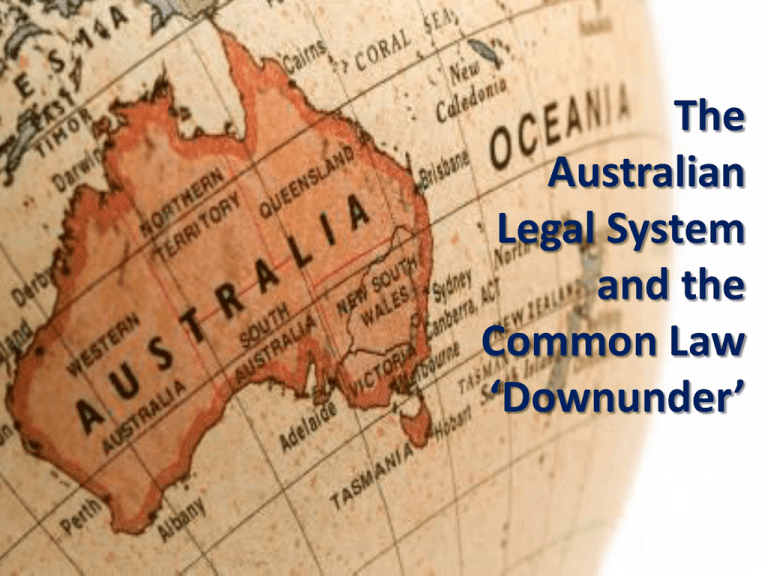Equity - Scienze Politiche
advertisement

The Australian Legal System and the Common Law ‘Downunder’ Yesterday: • Introduction – Common law vs Civil Law – Common law vs Statute – Common law vs Equity • • • • • Norman Invasion of England Itinerant justices (of Eyre and of Assize) Curia Regis: the origin of Westminster courts Writ System and sclerosis of the common law Development of Modern Parliamentary Democracy Today: • Development of Modern Parliamentary Democracy and the rise of the statute • Equity • Doctrine of Precedent • Australian Legal System: – European Discovery – Colonisation and Development – Federation – Independence – An Australian Republic? • Magna Carta 1215 • http://www.magnacarta.senate.gov.au/ • 1265 Simon De Montfort’s Parliament • 1295 Model Parliament King Edward I • • • • Henry VIII James I 1603 -1625 (James VI of Scotland) Charles I 1625 - 1649 The Commonwealth Period under Lord Protector Oliver Cromwell • Charles II 29 May 1660 - 1685 • James II 61685-88 • Glorious Revolution of 1688 • William and Mary • Bill of Rights 1689 • Act of Settlement 1701 • Rule of Law • Separation of Powers The role of the Statute Equity: The jurisdiction of The Court of Chancery Lord Chancellor: King’s principal legal officer and “the keeper of the King’s conscience.” English not Latin or Norman French No jury Focus on merits of the claims regardless of the technicality of forms/writs Its earlier decisions were binding upon itself. “The Office of the Chancellor is to correct Men’s consciences for Frauds, Breach of Trusts, Wrongs and oppressions, of what ever Nature soever they be, and to soften and mollify the Extremity of the Law … [W]hen a judgment is obtained by Oppression, Wrong and a hard Conscience, the Chancellor will frustrate it and set it aside, not for any error or Defect in the Judgment, but for the hard Conscience of the Party.” The Earl of Oxford’s Case (1615) 21 ER 485 The trust: an important feature of law and commercial life,for example: • Banking & Finance (securities clearing systems, unit trusts, custodianship of investments, bond issues) • Commercial (business trusts, nominee shareholders) • Wills & Estates (testamentary trusts) • Charities (charitable purpose trusts) • Family (family trusts, equitable interest of man and woman in family home) • Tax “minimisation” strategies • Superannuation & pensions What is a trust? A device by which one person (trustee) holds property (trust property) for the benefit of another person (beneficiary) or for certain lawful purposes. Judicature Acts of 1873 and 1875 (UK) • Abolished both the Court of Chancery and the common law courts • Created one court – the High Court of Judicature with five divisions: – Queen’s Bench, Exchequer, Common Pleas, Chancery & Probate, Divorce & Admiralty THE DOCTRINE OF PRECEDENT THE DOCTRINE OF PRECEDENT stare decisis et non quieta movere (stand by the thing decided and do not disturb the calm) • • • • CERTAINTY EQUALITY EFFICIENCY APPEARANCE OF JUSTICE Telstra Corporation v Treloar (2000) 102 FCR 595, 602 (Branson and Finkelstein JJ) ‘Our common law system consists in the applying to new combinations and circumstances those rules of law which we derive from legal principles and judicial precedents; and for the sake of obtaining uniformity, consistency and certainty we must apply those rules where they are not plainly unreasonable and inconvenient, to all cases which arise; and we are not at liberty to reject them, and to abandon all analogy to them, in those to which they have not been judicially applied, because we think that the rules are not as convenient and reasonable as we ourselves could have devised.’ Mirehouse v Rennell (1833 1 Cl and F 527; 6 ER 1015 at 546 per Parke B) Authorised Law Reports are central to the doctrine of precedent Doctrine of Precedent: in summary • Each court is bound by decisions of courts in its hierarchy • A decision of a court in a different hierarchy or lower in the same hierarchy may be persuasive, it will not be binding • Generally a court will not consider itself bound by its own past decisions but will depart from them only reluctantly • Only the ratio decidendi of a past decision is binding • Obiter dicta are not binding but may be persuasive • Precedents do not lose their force by lapse of time JUDICIAL REASONING or HOW COURTS CAN AVOID A PRECEDENT • Distinguish it on the facts – • Eg Thornton v Shoe Lane Parking [1971] 2 QB 163 Statement of law is too wide – eg Attorney-General for New South Wales v Mundey [1972] 2 NSWLR887 – Ex parte Attorney-General; Re Truth and Sportsman Ltd [1961] SR(NSW) 484 ‘any statements or comment dealing with the case and propounding views as to its proper determination are calculated to obstruct, or tend to obstruct, the administration of justice and to make the task of the court entertaining the appeal both difficult and embarrassing.” • • Statement of law is obiter dictum Changed social conditions – – • • • R v L (1991) 174 CLR 379 http://www.austlii.edu.au/au/cases/cth/HCA/1991/48.html R v. R. [1992] 1 AC 599, 612-623 http://www.bailii.org/uk/cases/UKHL/1990/9.html Precedent Unsatisfactory Precedent is wrongly decided But what about when there is no precedent? THE AUSTRALIAN LEGAL SYSTEM: the common law ‘downunder’ 1606: Willem Janszon (Dutch) 1622: British East India Company ship The Tryall wrecks on the west coast 1642: Abel Tasman (Dutch) sighted Tasmania on the way to discovering New Zealand, Fiji and visiting New Guinea 1688: William Dampier (English), landed on the west coast 19 April 1770: Captain James Cook in The Endeavour sighted the east coast of Australia and ten days later landed in a bay now located in Sydney's south 22 August 1770: Cook took possession of most of the East coast for the British – with an undefined western boundary. 26 January 1788: First Fleet arrived in Sydney Other colonies established thereafter http://upload.wikimedia.org/wikipedia/commons/5/55/Australia_history.gif • Australian colonies established largely as a place to deposit convicts whose death penalties had been commuted to transportation • 160,000 convicts were transported to the Australian colonies • until: • 1852 New South Wales • 1852 Tasmania • 1868 Western Australia ‘[Aboriginal Australians] may truly be said to be in the pure state of nature, and may appear to some to be the most wretched upon the earth; but in reality they are far happier than ... we Europeans.’ Captain James Cook 23 August 1770 TERRA NULLIUS: ‘It has been held that if an uninhabited country be discovered and planted by English subjects all the English laws then in being, which are the birthright of every English subject, are immediately there in force. But this must be understood with very many and very great restrictions. Such colonists carry with them only so much of the English law as is applicable to their new situation as the condition of an infant colony…’ Blackstone http://data.worldjusticeproject.org/ New South Wales Act 1823 (Imp) Australian Courts Act 1828 (Imp) (s24) •all common law and statute law of Britain was imported into New South Wales (and Queensland and Victoria) on 25 July 1828. •South Australia: 28 December 1836 •Western Australia: 1 June 1829 Australian Constitutions Act (No 1) 1842 – introduced a number of reforms that created for the first time three separate branches of government Australian Constitutions Act (No2) 1850 - Allowed colonies to form their own constitutions and parliaments For example in South Australia: Became a self-governing colony in 1856 A bicameral parliament was elected on 9 March 1857 Constitution provided for: • Adult male suffrage (including indigenous men) (no property requirement); • Secret ballot voting; one man, one vote; • No property qualifications for Members of its House of Assembly and a relatively low property qualification for Members of its Legislative Council In 1894 women in South Australia : • were given the right to vote; and • and were the first women in the world to be able to stand for parliament. Federation: 1 January 1901 Independence •World War 1 and Treaty of Versailles •Consitutional Crisis in Canada and the Balfour Declaration of 1926 •World War 2 •Statute of Westminster (Imp) 1931 •Statute of Westminster Adoption Act (Cth) 1942 Privy Council (http://www.jcpc.uk/index.html) Independence The Australia Acts enacted by both the Australian and in the United Kingdom Parliament in 1986 Queen visits Australia in 1963: An Australian Republic? •http://www.youtube.com/watch?v=6ibGwqMM6uU Looking back on the 1999 Republic Referendum: •http://youtu.be/rNM3iyCH4do Queen visits Australia in 2011: •http://youtu.be/cfOZ61I5V4E











